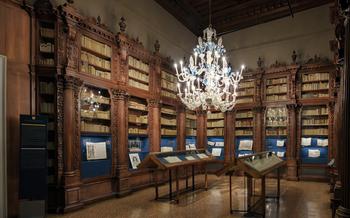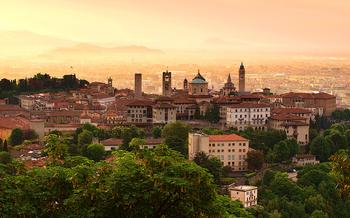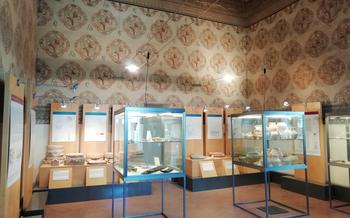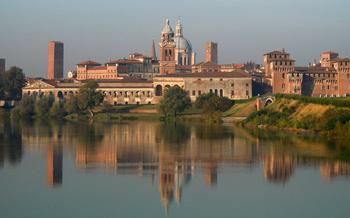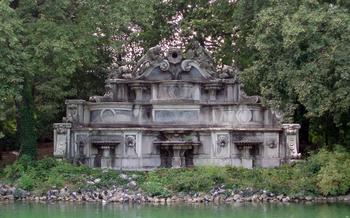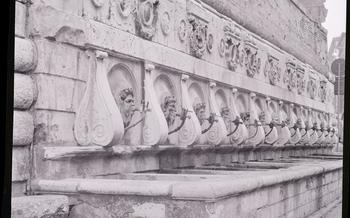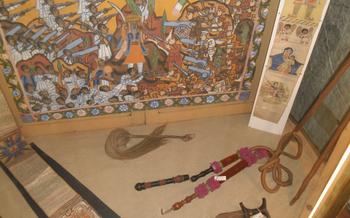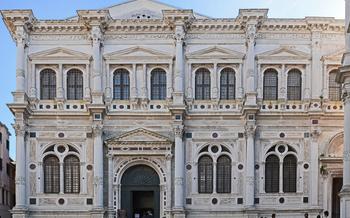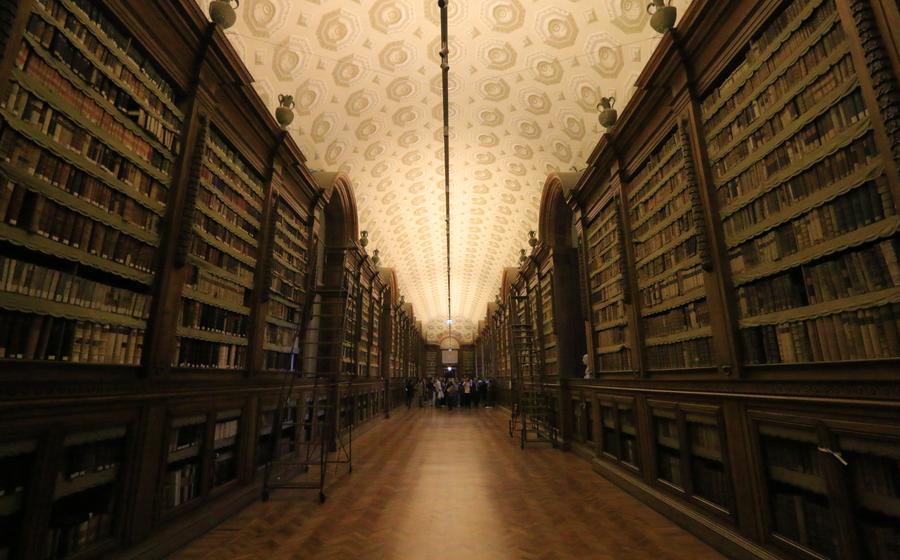
Biblioteca Palatina
- The Biblioteca Palatina: A Treasure Trove of Knowledge and Beauty
- History
- Renaissance Masterpieces
- Codices
- Bibles
- Maps and Atlases
- Scientific Works
- Music Collection
- Exhibitions
- Architecture
- Research Facilities
- Guided Tours
- Hours of Operation
- Admission Fees
- Insider Tip:
The Biblioteca Palatina: A Treasure Trove of Knowledge and Beauty
Nestled in the heart of Parma, Italy, the Biblioteca Palatina is a majestic repository of knowledge and beauty that invites visitors on an extraordinary journey through history, art, and culture. Founded in the 18th century by the Duke of Parma, Antonio Farnese, the Biblioteca Palatina has evolved into one of Italy's most prestigious and renowned libraries, housing a staggering collection of over 800,000 volumes, including rare and precious manuscripts, incunabula, and printed editions that span centuries of human thought and creativity.
The Biblioteca Palatina is not merely a library; it is a living testament to the power of the written word, a place where the past and present converge to inspire future generations. Its opulent halls and meticulously curated collections have captivated scholars, bibliophiles, and art enthusiasts from around the world, making it a must-visit destination for anyone seeking knowledge, enlightenment, and aesthetic wonder.
History
The Biblioteca Palatina can trace its origins back to the 10th century, when it was established as the private collection of the marquesses of Parma. Over the centuries, the collection grew substantially through donations, purchases, and bequests, and it eventually became one of the most important libraries in Europe. In 1761, the library was made public and placed under the patronage of the Duke of Parma. It was then that the collection was enriched with the acquisition of the private libraries of the Farnese family, the dukes of Parma, and the Jesuit college of Parma. Later on, the library incorporated several other collections, including those of the monasteries suppressed by Napoleon and the episcopal seminary. Today, the Biblioteca Palatina boasts an impressive collection of over 800,000 volumes and is considered one of the most significant cultural institutions in Italy. It is a treasure trove of knowledge and a testament to the rich history and cultural heritage of the city of Parma and the region of Emilia-Romagna.
Renaissance Masterpieces
The Biblioteca Palatina is home to a treasure trove of Renaissance masterpieces that are sure to captivate art aficionados and history buffs alike. Among the highlights of the collection are exquisite illuminated manuscripts, adorned with intricate miniatures and vibrant colors that transport visitors back in time. These manuscripts offer a glimpse into the artistic and cultural achievements of the Renaissance, showcasing the exceptional craftsmanship and creativity of the period.
Equally remarkable are the incunabula, a term used to describe books printed before 150The Biblioteca Palatina boasts a collection of over 6,000 incunabula, making it one of the most significant in the world. These early printed books provide valuable insights into the development of printing technology and the dissemination of knowledge during the Renaissance.
The collection also includes a wealth of rare editions of literary and scientific works from the Renaissance period. These include first editions of pivotal texts, such as Dante's Divine Comedy, Petrarch's Canzoniere, and Boccaccio's Decameron. These rare and valuable books offer a tangible connection to the intellectual and cultural currents that shaped the Renaissance.
Codices
Among the treasures housed within the Biblioteca Palatina, the collection of precious codices stands out as a testament to the institution's rich history and commitment to preserving cultural heritage. These handwritten manuscripts, meticulously crafted by skilled scribes and adorned with exquisite illuminations, offer a glimpse into the intellectual and artistic achievements of past centuries.
One of the most remarkable codices is the Codex Aureus, a stunning gospel book created in the 9th century. Its pages are adorned with shimmering gold leaf, intricate calligraphy, and vibrant miniatures that bring biblical scenes to life. The Codex Aureus is a testament to the mastery of medieval craftsmanship and a valuable source of insight into early Christian iconography.
Another notable codex is the Virgil's Aeneid, dating back to the 5th century. This beautifully preserved manuscript contains Virgil's epic poem, the Aeneid, one of the foundational works of Latin literature. Its historical significance is matched by its artistic value, as the manuscript features elegant script and delicate illustrations that enhance the storytelling.
A third highlight among the collection is the Hypnerotomachia Poliphili, an enigmatic and visually stunning book printed in Venice in 149With its intricate woodcuts and allegorical text, the Hypnerotomachia Poliphili is considered a masterpiece of Renaissance book design and offers a glimpse into the intellectual and artistic currents of the era.
Visiting the Biblioteca Palatina and exploring its collection of codices is a journey through time, allowing visitors to delve into the minds and imaginations of scribes, scholars, and artists from centuries past. These precious manuscripts are not only objects of historical significance but also works of art that captivate the senses and ignite the imagination.
Bibles
The Biblioteca Palatina houses a remarkable collection of Bibles, boasting rare and significant editions that offer a glimpse into the history of biblical scholarship and printing. Among the highlights are the renowned Gutenberg Bible, printed by Johannes Gutenberg in Mainz around 1455, which stands as one of the earliest surviving examples of movable type printing. This magnificent volume revolutionized the production and dissemination of books, marking a pivotal moment in the development of print culture.
Another significant treasure is the Complutensian Polyglot Bible, printed in Alcalá de Henares, Spain, between 1514 and 151This groundbreaking work was the first polyglot Bible to be printed, featuring the biblical text in multiple languages, including Hebrew, Greek, and Latin. It represents a testament to the remarkable scholarship and dedication of the humanist scholars who worked on this monumental project.
These Bibles, along with other valuable editions, provide researchers and visitors with an unparalleled opportunity to delve into the history of biblical texts and explore the diverse ways in which the Bible has been transmitted, translated, and interpreted throughout the centuries.
Maps and Atlases
The Biblioteca Palatina also houses a notable collection of ancient and historical maps and atlases, providing valuable insights into the world's cartographic history. Among the highlights is a collection of Ptolemaic maps, dating back to the 2nd century AD. These maps, based on the theories of the ancient Greek geographer Ptolemy, offer a glimpse into the geographical understanding of the world during that era.
Another significant part of the collection is the Venetian atlases, produced by renowned cartographers from the Republic of Venice. These atlases, adorned with intricate illustrations and decorative elements, showcase the artistic and scientific advancements of the Venetian Republic during the Renaissance period.
The Biblioteca Palatina's collection of maps and atlases is a treasure trove for scholars and history enthusiasts alike, providing a unique perspective on the evolution of cartography and the exploration of the world.
Scientific Works
Among the treasures housed within the Biblioteca Palatina, a remarkable collection of scientific works holds a prominent place. These invaluable texts, penned by some of history's most renowned scholars, offer a glimpse into the intellectual pursuits and discoveries that shaped our understanding of the natural world.
One of the highlights of this collection is Galileo Galilei's Sidereus Nuncius, a groundbreaking work that revolutionized our perception of the cosmos. Through his meticulous observations of the night sky using a telescope, Galileo challenged prevailing notions and provided compelling evidence in support of the heliocentric theory. His detailed descriptions of the phases of Venus, the discovery of Jupiter's four moons, and the observation of sunspots marked a pivotal moment in the history of astronomy.
Another scientific masterpiece found within the Biblioteca Palatina is Andreas Vesalius's De Humani Corporis Fabrica, a seminal work in the field of anatomy. This exquisitely illustrated volume, published in 1543, provided the first accurate and comprehensive depiction of human anatomy, based on Vesalius's meticulous dissections. His groundbreaking work revolutionized medical education and set the foundation for modern anatomical studies.
These scientific works, along with many others, stand as testaments to the Biblioteca Palatina's role as a repository of knowledge and a catalyst for scientific advancement. Visitors can delve into the depths of these remarkable texts, gaining insights into the minds of the scientific pioneers who transformed our understanding of the universe and the human body.
Music Collection
The Biblioteca Palatina houses a remarkable music collection, a treasure trove for music enthusiasts and scholars alike. The collection boasts a vast array of manuscripts, scores, and treatises that span centuries of musical history. Among its notable highlights are handwritten manuscripts of operas by renowned composers such as Wolfgang Amadeus Mozart and Giuseppe Verdi. These manuscripts offer a glimpse into the creative process of these musical geniuses, providing insights into their compositional techniques and the evolution of their musical ideas.
The Biblioteca Palatina's music collection also encompasses a significant number of early printed editions of music, including rare and valuable scores from the Renaissance and Baroque periods. These editions provide a tangible connection to the music of the past, allowing researchers and performers to delve into the historical context and performance practices of different eras.
Moreover, the Biblioteca Palatina houses a collection of music treatises that document the theoretical and pedagogical aspects of music from the Middle Ages to the present day. These treatises offer valuable insights into the development of musical thought and the changing approaches to music education and performance.
The music collection at the Biblioteca Palatina is a testament to the institution's commitment to preserving and celebrating the rich heritage of Western music. It serves as a resource for scholars, musicians, and music lovers alike, providing a unique opportunity to explore the diverse and fascinating world of music through its historical artifacts.
Exhibitions
The Biblioteca Palatina often hosts temporary exhibitions and special events, allowing visitors to experience the library's treasures in new and engaging ways. These exhibitions showcase specific collections, highlight the work of renowned scholars and artists, or explore particular themes related to the library's history and holdings.
Past exhibitions have covered themes such as the history of printing, the art of illumination, and the scientific discoveries of the Renaissance. Visitors have had the chance to admire rare books, manuscripts, maps, and scientific instruments up close, and to learn about the fascinating stories behind these objects.
Exhibitions are typically held in the Biblioteca Palatina's grand halls, providing a stunning backdrop for the displayed items. Visitors can expect to find interactive displays, multimedia presentations, and detailed explanations that bring the exhibits to life.
To stay up-to-date on upcoming exhibitions and events, visitors can check the Biblioteca Palatina's website or social media pages. Advance booking is recommended for popular exhibitions, especially during peak tourist season.
Architecture
The Biblioteca Palatina is housed in a grand and imposing building that is a testament to the architectural achievements of the Renaissance period. The main entrance leads into a spacious atrium adorned with intricate frescoes and sculptures. The library's most striking feature is its series of grand halls, each with its own unique character. The Sala dei Mappamondi, or Hall of Globes, is home to a collection of antique globes and celestial spheres. The Sala della Musica, or Music Room, features a vaulted ceiling decorated with musical symbols and instruments. The Sala Borbonica, or Bourbon Room, is the largest and most opulent hall, named after the Bourbon dynasty that ruled Parma in the 18th century. It showcases a collection of rare books and manuscripts, as well as a series of portraits of the Bourbon rulers. The Biblioteca Palatina's architecture blends functionality with aesthetic beauty, creating a space that is both inspiring and conducive to learning.
Research Facilities
The Biblioteca Palatina offers a comprehensive range of research facilities to scholars and researchers. The reading rooms provide a quiet and comfortable environment for study, with access to reference works, catalogs, and digital resources. The library's catalogs are available online, allowing researchers to search for specific items and plan their visits accordingly. The Biblioteca Palatina also provides digital resources, such as digitized manuscripts and rare editions, which can be accessed remotely. These resources are invaluable for researchers who are unable to visit the library in person or who wish to conduct research from their own institution. Additionally, the library staff is highly knowledgeable and helpful, and they are available to assist researchers with their inquiries.
Guided Tours
The Biblioteca Palatina offers guided tours for visitors, allowing them to experience the wonders of the collection up close and learn about its rich history and significance. These tours are conducted by knowledgeable guides who provide insights into the individual pieces and the overall collection and available in several languages to accommodate international visitors, subject to availability. Visitors can choose from various tour options, including general overviews and specialized tours that focus on specific topics or themes.
To ensure a spot on the tour and avoid disappointment, advance booking is highly recommended. Reservations can be made online or by calling the Biblioteca Palatina directly. Visitors should arrive at the designated meeting point within the library a few minutes before the tour's scheduled starting time. For those unable to book in advance, a limited number of walk-up tour tickets may be available on a first-come, first-served basis.
Hours of Operation
The Biblioteca Palatina follows regular opening hours, allowing visitors to explore its treasures at specific times. The library is generally open from Tuesday to Saturday, with varying hours depending on the season. During the summer months, it operates from 8:30 AM to 1:30 PM, while in the winter, the hours are slightly shorter, from 8:30 AM to 12:30 PM. It is recommended to check the library's website or contact them directly to confirm the exact hours of operation, as they may occasionally change due to holidays or special events. It's essential to plan your visit accordingly to make the most of your time exploring the Biblioteca Palatina's remarkable collection.
Admission Fees
Admission to the Biblioteca Palatina is subject to a fee, which varies depending on the type of visit and the services included.
The basic admission fee for individuals is usually around 10 euros and includes access to the library's permanent collections and temporary exhibitions. Reduced rates may be available for students, seniors, and groups.
For a more immersive experience, visitors can opt for a guided tour. Guided tours typically cost around 15-20 euros and offer a deeper insight into the library's history, collections, and highlights. Tours are available in various languages, including English, Italian, French, and Spanish, and can be booked in advance or on-site, subject to availability.
Admission to the Biblioteca Palatina is free on certain days of the week or during special events and initiatives. Visitors are encouraged to check the library's website or contact the information desk for up-to-date information on free admission days and any applicable conditions.
Insider Tip:
For a unique and immersive experience, plan your visit to the Biblioteca Palatina during the annual "Notte Bianca" (White Night) event, typically held in September. During this special evening, the library extends its hours and offers free admission, allowing visitors to explore its treasures and participate in cultural events, such as concerts, readings, and guided tours. It's an exceptional opportunity to experience the library's enchanting atmosphere under the moonlight and connect with other book lovers and history enthusiasts. Remember to arrive early to avoid long lines and make the most of this magical night.
